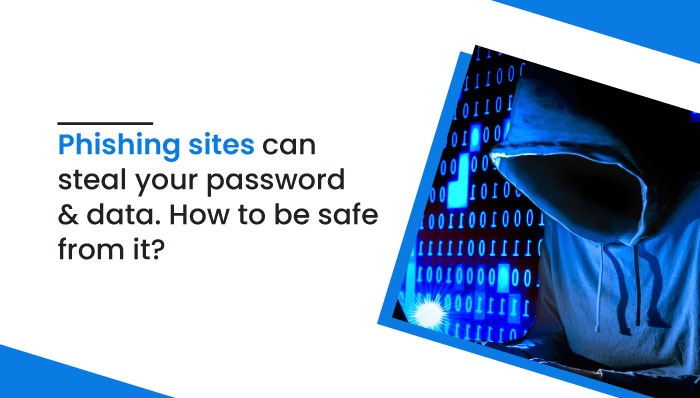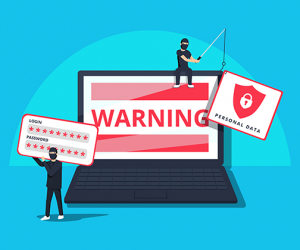Phishing sites can steal your password and data. How to be safe from it?

Phishing sites can steal your password and data. How to be safe from it?
Phishing is a method of trying to gather personal information using deceptive emails and websites. It is an increasingly sophisticated form of cyberattack. The goal of phishing is to trick an email recipient into believing that the msg is something they want or need. If you don’t know how to be safe from phishing sites, they can easily steal your password and data.
For instance, a request from their bank, a note from someone from their company and to click a link or download an attachment, or a mail to change their password are some of the common phishing attacks used by scammers to get your password and information.
In this blog, I will write about how phishers can easily steal your password and data and also the ways you can be safe and protect yourself from falling to these phishing emails and sites.
What is Phishing?
The word “Phish” in phishing is pronounced just like it is spelled, just like “fish.” The analogy is of an angler throwing a baited hook out there as a phishing email and hoping you bite.
What distinguishes phishing is that the attacker masquerades as a trusted friend, worker, relative, or an entity of some kind, often a real or plausibly actual person or a company the victim might do business with. It might also be a bank, company, or software that you use.
How do Phishing Sites Steal your Password and Data?
 Phishing is the easiest way of stealing someone’s password or data. How do these sites steal your data, and how to be safe from these phishing sites?
Phishing is the easiest way of stealing someone’s password or data. How do these sites steal your data, and how to be safe from these phishing sites?
Firstly, hackers find your email on your social site or from the company site you currently are working on. Then they send you a mail that looks as if it has been sent from your workplace, your bank, or your social site like to change your current Gmail account password or a bank account password.
When you click on the link, the hacker will redirect you to their website, the replica of your bank, Gmail, or workplace website.
Without knowing anything, you enter your old password, trying to change it into a new one, and when you enter the password or any other data on that website, the hacker gets a hold of your account and other data. Hence you can be the victim of a phishing attack easily.
Read More: How to Keep Passwords Safe from hackers?
All the attacker has to do is clone the legitimate website whole log-in page is changed to point to a credential-stealing page or script. Then the modified files are bundled into a zipped file which is also called a phishing kit.
The zipped files are uploaded to the hacked website, where the files are again unzipped. And finally, the attacker sends the email to the victims with links pointing to the new spoofed website.
Real-time Consequential Phishing
Perhaps one of the most consequential phishing happened in 2016 when Russian hackers managed to get Hillary Clinton campaign chair John Podesta to offer his personal Gmail account password.
So how did they do it? The hackers sent an email to John Podesta that someone had his password and should change it immediately. Clicking on the link of that email took him to a fake log-in page.
In this way, the hacker got access to John Podesta’s password and all critical data and information. This scam is a classic ploy and one all of us would hope to see for what it is.
Types of Phishing
Based on intent, phishing can be done for two different intents. The first one is to obtain sensitive information. The phishing technique is designed to deceive the recipient into disclosing sensitive information, such as a username and password, which the attacker may use to gain access to a device or account.
The other one is to download malware or spyware on the victim’s device. These phishing emails are designed to trick the recipient into installing malware, spyware, or ransomware on their device. Messages are frequently “soft targeted.” They may, for example, be sent by an employer or a coworker with an attachment purporting to be a work-related job.
Spear Phishing
Sending emails to clear and well-researched targets by posing as a trustworthy sender is known as spear phishing. The aim is to infect computers with malware or persuade victims to divulge personal information or assets.
Hackers use information from social media platforms like LinkedIn to identify their targets and send emails that seem to be from coworkers using spoofed addresses. For example, a spear phisher could target someone in the finance department and pose as the victim’s boss, demanding an urgent large bank transfer.
Smishing
Smishing is another kind of phishing in which someone uses a phone call or an SMS message to trick you into giving them your details. In the field of online security, smishing is becoming an emerging and rising threat.
Smishing employs social engineering techniques to persuade you to share personal knowledge. To obtain your facts, the strategy of smishing takes advantage of your trust.
A hacker can be searching for something from your online credentials to your bank account information or one-time passwords (OTPs) to obtain access to your accounts. Once the attacker has your credentials or required data, they will use it to carry out various attacks.
Whaling
Whale phishing, also known as whaling, is spear phishing that targets the big fish, such as CEOs, executives, and other high-value targets. Many of these scams threaten company board members, who are deemed especially vulnerable because they wield significant power within a company.
However, they aren’t full-time staff; they often use personal email addresses for business-related communications, which lacks the security provided by corporate email.
How to be Safe from Phishing Sites?
Email and website scammers are constantly honing their crafts, trying new pitches, and pulling new strings. Hence you should be alert to protect yourself from them. Here are some things you can do to protect yourself from phishing.
Know about the types of emails that scammers can send you
One way to get familiar with their tactics is to study the email messages that scammers send. Here I have enlisted a few of those scam emails that a hacker can send to phish you.
Your account has been hacked.
The first one is “Your account has been hacked.” The person sending this threatening phishing message found a group email publicly available on the company site.
Reset your Password
The second one is “Reset your Password.” Taking advantage of the fact that no one wants to miss their paycheck, messages like this aim to trick the user into revealing important data, often a username or password that an attacker can use to breach a system or an account.
Payment request
The third one is “Payment request.” This email has enough information specific to the target company to give even the most phishing-savvy recipients a pause. Know your company’s processes and spot anomalies so that you don’t catch yourself in this trap.
Charity donation
The fourth one is “Charity donation.” Here the scammer is counting on the greed and gullibility of the recipient. This theme of gigging something away for free is a common one and preys on human nature. The critical thing to remember is, if it sounds too good to be true, it probably is.
Check the website properly before entering your information.
When you get an email from anyone, maybe it can be from your work or your bank, friends, and family. Do not respond or take action to that immediately. Take a moment to examine that email.
Check for spelling or grammatical mistakes in domain names or email addresses. Hackers or scammers most frequently use email addresses that mimic well-known businesses or companies’ names but change them subtly.
The hacker sends ‘[email protected]’ can be sent instead of ‘[email protected].’ Both of the emails look the same to the receiver at a glance. Without thinking anything, the receiver responds to the message and clicks on the URL.
But if you look carefully, you can notice that the first email address has three ‘o’ in ‘yahoo’ and is the fake one. Likewise, the hacker can redirect to the website ‘gmall.google.com’ instead of ‘gmail.google.com.’ So you always have to notice these tiny changes carefully that the phisher uses to scam you.
Don’t fall for cyber threats.

Phishers often use threats that your password has been breached or that your account has been blocked. It would be best if you did not fall for these ruses. Always remember that ‘Haste makes waste.’ Don’t act immediately upon it.
Most of the time, such threats are just false alarms to frighten the victim. Phishers try to make them give their information up in a panic. Therefore, when these situations appear, stay calm. Take your time to evaluate the situation and consider your options.
Don’t neglect Updates Notifications:
When you received many update notifications, you might be frustrated and start to neglect them. But you shouldn’t do it. Because updates are mostly released to keep up to date with modern cyber-attack. You can be the victims of easily avoided risks and vulnerabilities due to the habit of ignoring updates. That’s why take a minute to download and install the updates.
Use Antivirus Software and Firewalls:
Antivirus software and firewalls are used to prevent external attacks and work as a shield between your device and phishing sites. It’s better to use a network firewall and desktop firewall because it reduces the chance of hackers. In order to be safe from phishing sites, the use of antivirus software is highly recommended.
Read More: How does online monitoring help your teen get rid of online scams?
My Final Thoughts
If you don’t know how to be safe from phishing sites, they can easily steal your password and data. You are in charge of your safety. Always be careful and vigilant. Often keep in mind that someone, somewhere, is attempting to hack you. The simple security precautions outlined above will shield you from the majority of hacking attempts.
Before you open links, think twice. If you see a connection in an email message that looks strange, don’t click on it. Instead, hover your mouse over the connection. Then see if it’s the same URL as the one included in the post.
Remember not to be in a panic when you receive any cyberthreat. Always assess the situation and protect yourself from phishers scamming you.



 WhatsApp Spy
WhatsApp Spy Facebook & Messenger Spy
Facebook & Messenger Spy Viber Spy
Viber Spy Instagram Spy
Instagram Spy Skype Spy
Skype Spy TikTok Spy
TikTok Spy Telegram Spy
Telegram Spy LinkedIn Spy
LinkedIn Spy Twitter Spy
Twitter Spy Youtube Spy
Youtube Spy Photo Spy
Photo Spy Video Spy
Video Spy Calls and Contacts Tracking
Calls and Contacts Tracking SMS & IM Chats
SMS & IM Chats Voice Capture
Voice Capture Image Capture
Image Capture Video Record
Video Record